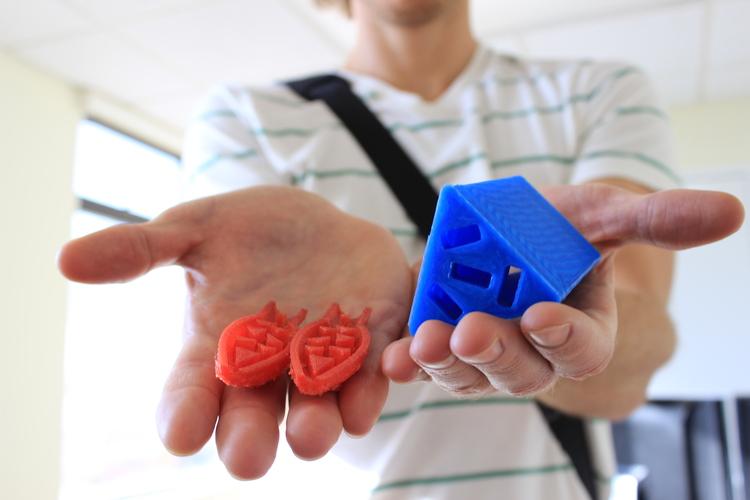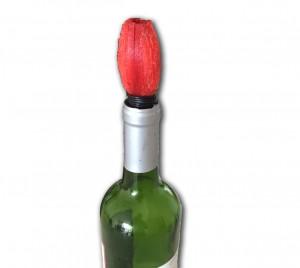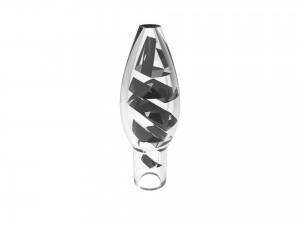3D printed products have made some amazing headway in critical applications. We’ve seen fantastic, futuristic uses in the medical and aerospace fields, to name just a couple. And of course we’ve seen some pretty silly uses, too, like little toys and desk doodads that may not really be necessary, but sure are fun. Somewhere between these two ends of the spectrum are the simply functional, and that’s where a wonderful new product for wine drinkers comes in.

Traditional vinturi type wine aerator
I’m not going to pretend wine is a critical need, but let’s face it; at the end of a long day, nothing tops off an evening quite like a nice glass of wine. I know I’m not patient enough to decant every bottle I open, and looking at the sheer number of wine aerators on the market, I know I’m not alone.
Wine aerators are simple devices through which wine can be poured, acting as almost an instantaneous decanting, allowing the wine to “breathe” and open some of the flavors. Most aerators available now are of the vinturi type: the wine enthusiast simply pours wine from the bottle through the aerator, and into the glass to have air mixed into their red wine.
While most people accept vinturi aerators as the standard, two men thought they could create a better way. Florida-based Ottermatics is a design firm founded by Aleksey Matyush ev (Principal Solutions Tinkerer) and Kevin Russell (Chief Overanalyzer), who set out on a mission to create a superior aerator.
ev (Principal Solutions Tinkerer) and Kevin Russell (Chief Overanalyzer), who set out on a mission to create a superior aerator.
Matyushev and Russell have unique backgrounds making them particularly well-suited to think about their approach from a different angle. Their experience in aircraft aerodynamics and hydrodynamics inspired them to use the concept of a turbulating effect for their aerator. Similar to turbulence on an aircraft, turbulating the wine slows and tosses — rather than accelerating — the wine sent through the aerator.
While seated at the drawing table, they also thought they could address some other problems specific to handheld vinturi aerators, such as: holding an aerator above a glass can lead to spillage, some aerator designs leak, and using a two-handed pour method can be simply inconvenient. To these ends, the pair thought to include their aerator design into the pouring process itself, eliminating the middle man mentality of holding a completely separate piece of equipment.

The first prototype
Matyushev and Russell knew what they wanted to do — but it was figuring out how to go about it that brought their ideas to our attention. Matyushev and Russell had ideas on their turbulating theory, but weren’t sure about the best array of triangles in the device to achieve the desired effect. Traditional means, like making a computational fluid dynamics (CFD) model and doing fluid dynamics analyses through several iterations, would be expensive and prevented them from tasting the results. They needed rapid prototyping, and saw their answer in 3D printing.
By using additive manufacturing in their prototyping process, the Ottermatics team could create physical, workable aerators and actually test them with real wine. Taste, after all, is the key to the whole process here. Fortunately, Ottermatics had a Solidoodle 4 3D printer already, and set out to work.
Because their CAD designs are relatively simple, not requiring high resolution or precision, they could create an iteration of the wine aerator in just 45 minutes. In under an hour, the team could go from an idea to testing and sipping the aerated wine. I don’t think I could get to the store and back with an aerator ready to go in that time.
Of course, the first prototype wasn’t exactly right. Fortunately though, they could make about six iterations in a single day, and by day two of their task, the Ottermatics team had found their winner. The same process would have taken about two weeks — and maybe $700 in tooling costs — to get to the final design test. Using a CFD model, each design would have required around five hours of analysis before creating each iteration. Using CAD, the process took closer to 10 minutes to rearrange the internal triangle array before the next prototype was ready to start printing.
The ninth iteration came out so well, and their wine tasted so good using it, that they took it to a wine bar to test it out in the real world. Pitted against a leading acrylic aerator in a blind taste test, the 3D printed prototype dominated. Every taster selected the wine aerated using the 3D printed piece over the market leading piece.
I think I know what I’ll be on the lookout for next time I’m in the market for an aerator. This innovative prototype’s concept rendering is a far sleeker design than the red 3D printed prototype, and I hope the Ottermatics team keeps at this project!
What do you think? Do you use wine aerators? Would you use one designed this way? Let us know your thoughts in the 3D Printed Wine Aerator forum thread over at 3DPB.com.
Subscribe to Our Email Newsletter
Stay up-to-date on all the latest news from the 3D printing industry and receive information and offers from third party vendors.
Print Services
Upload your 3D Models and get them printed quickly and efficiently.
You May Also Like
3D Printing News Briefs, July 2, 2025: Copper Alloys, Defense Manufacturing, & More
We’re starting off with metals in today’s 3D Printing News Briefs, as Farsoon has unveiled a large-scale AM solution for copper alloys, and Meltio used its wire-laser metal solution to...
Etsy Design Rule Change Reduces Selection of 3D Printed Goods
Online marketplace Etsy has implemented a rule change requiring all 3D printed goods on the site to be original designs. The update to the site’s Creativity Standards states, ¨Items produced using...
Siraya Tech Introduces New Elastomer 3D Printing Materials, Including Foaming TPU
California company Siraya Tech, founded in 2019 with a focus on material science, customer focus, and agility, develops high-quality 3D printing materials that meet the needs of creators, hobbyists, and...
3D Printing News Briefs, April 12, 2025: RAPID Roundup
The news from last week’s RAPID+TCT in Detroit just keeps on coming! That’s why today’s 3D Printing News Briefs is another RAPID Roundup of more exciting announcements from the trade...




































